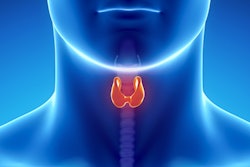
Patients with low-risk papillary thyroid cancer up to 1.5 cm in size can be safely managed by active surveillance, avoiding unnecessary surgery and any associated expense and potential complications, according to research published online in Thyroid.
In a retrospective review of nearly 700 patients, a research team led by Dr. Andrew Griffin and senior author Dr. Jenny Hoang of Duke University Medical Center concluded that almost 25% of patients with low-risk papillary thyroid cancer could have been safely managed with active surveillance if a threshold cancer size of 1.5 cm on ultrasound was used. A 1-cm threshold, however, would have led to active surveillance being offered to only 6% of papillary thyroid cancer cases, while individuals with cancers up to 1.5 cm received surgical procedures that might not be necessary (Thyroid, January 26, 2017).
"Thyroid surgery is low-risk, but there are costs and potential permanent complications," Hoang told AuntMinnie.com. "If the tumor is indolent and may never progress, carefully monitoring the tumor with active surveillance seems to be a very reasonable alternative."
Low-risk cancer
Thyroid cancer has traditionally been treated with thyroid surgery. However, 2015 guidelines from the American Thyroid Association (ATA) indicate that "an active surveillance management approach can be considered as an alternative to immediate surgery" in patients with low-risk papillary thyroid cancer. This management strategy targets the problem of overtreatment of thyroid cancers that are indolent in behavior, Hoang noted.
"There is mounting evidence that it can be considered as a safe alternative to immediate surgery in selected patients," she said.
 Dr. Jenny Hoang of Duke University Medical Center.
Dr. Jenny Hoang of Duke University Medical Center.To explore the potential effects an active surveillance management program would have on clinical practice, the research team performed a retrospective study to identify how many papillary thyroid cancer cases would meet the criteria for active surveillance and to determine how many surgeries and complications could have been avoided.
The researchers reviewed the medical records of 681 thyroid cancer patients who had thyroid surgery at Duke University Medical Center between 2003 and 2012, using imaging and patient characteristics to identify cases that would fall under the Memorial Sloan Kettering Cancer Center (MSKCC) risk criteria for active surveillance in patients with papillary thyroid cancer. The group then reviewed the management and outcomes for these patients.
Of the 681 thyroid cancer patients, 243 were diagnosed with papillary thyroid cancer based on fine-needle aspiration (FNA) histology using the Bethesda System for Reporting Thyroid Cytopathology, which categories thyroid nodules as V (suspicious for malignancy) or VI (malignant). Seventy-seven patients had nodules that were 1.5 cm or smaller on ultrasound; 56 (23%) of overall papillary thyroid cancer cases met the criteria for surveillance.
Of these 56 nodules, 15 (6% overall) were 1 cm or smaller and 41 (17%) were 1.1 cm to 1.5 cm in size. As a result, increasing the threshold to 1.5 cm or smaller would allow an additional 17% of papillary thyroid cancer cases to be managed with surveillance.
In their study, 93% of the patients who would have met the criteria for surveillance actually underwent total thyroidectomy. Of these patients, three (5%) had permanent complications, including vocal cord paralysis, permanent hypoparathyroidism, and a chipped tooth from intubation.
None of the patients who would have met the criteria for surveillance died or experienced disease recurrence.
A new biopsy threshold?
A 1-cm size threshold -- as used in Japan -- will allow only a very small proportion of patients with papillary thyroid cancer to be eligible for active surveillance, Hoang said. That's because thyroid nodules smaller than 1 cm are rarely biopsied in the U.S., in accordance with recommendations by the ATA and the Society of Radiologists in Ultrasound.
"Raising this threshold is safe since [Surveillance, Epidemiology, and End Results database] data shows 10-year relative survival for thyroid cancers measuring 0.5-0.9 cm and 1.0-1.9 cm are the same (99.8%)," Hoang said.
She noted that the 1.5-cm threshold was used in a study at MSKCC, which does have a formal active surveillance program. For its part, Duke is moving toward a more conservative approach to low-risk papillary thyroid cancer, with lobectomy offered as an alternative to total thyroidectomy, Hoang said.
"Although there is no formal active surveillance program, selected patients with high-risk comorbidities and advanced age are offered active surveillance," she said. "Some of our patients come from remote locations and are resource-challenged. These factors and patient compliance contribute to the decision about surveillance."
All institutions should learn more about active surveillance and discuss the option with patients, Hoang said.
"The final decision of active surveillance versus surgery relies on what fits the institution's clinical practice and the individual patient," she said.
ACR white paper
Hoang is also a member of the American College of Radiology's Thyroid Imaging Reporting and Data System (TI-RADS) Committee, and she noted that the committee will publish its final white paper early this year. Furthermore, there are a number of new projects underway to gather data regarding this new management system, she said.
"We need recommendations and programs that reduce unnecessary thyroid biopsies, overdiagnosis of thyroid cancer, and overtreatment of indolent thyroid tumors," she said. "However, we also need evidence to support these strategies."




















